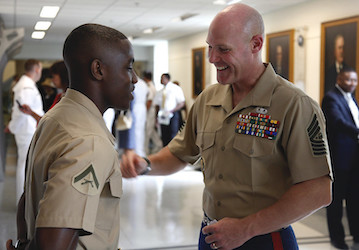When team members feel passionate and motivated at work, they’re more likely to perform better. Employee engagement and job satisfaction are both key metrics of teamwork and optimized performance within and outside of the military. When your team members are interested, enthusiastic, and committed to their work, they’re more likely to perform at higher levels and contribute to the overall betterment of the unit and the entire organization. Not only is a high level of engagement associated with improved performance, it actually drives it.
Engagement is important for retaining high-quality employees and Service Members beyond their initial enlistment commitments too. Engagement is also associated with high team cohesion, less conflict, and the ability to achieve coordinated action in the field.
Unfortunately, some estimates suggest over half of employees aren’t engaged (that is, they’re completing tasks, but lacking passion) at work. And many of those employees are actively disengaged, meaning their attitudes and actions can truly be detrimental to their colleagues and mission success.
Components of employee engagement
One primary aspect of keeping your team members and subordinates engaged with you, the unit, and your organization is by focusing on job satisfaction. As a leader, there might be many aspects of military life you can’t always control for your Warfighters (for example, benefits or compensation packages). The good news is that most of the top 10 aspects of job satisfaction are related to the relationship between supervisors (or commanding officers) and their subordinates, which you can control. In fact, most employees rank feeling respected and trusting their leaders as some of the most crucial contributing factors to job satisfaction and engagement.
Interpersonal leadership-engagement strategies
There are several ways leaders can build trust and foster healthy relationships to help create more committed, satisfied, and high-performing teams.
- Build your connections. Focus on creating genuine, professional relationships with your team members. It’s important to show you value their work, respect their time, and validate their contributions.
- Earn their trust. One aspect of gaining your team’s trust is to demonstrate ethical behavior and morality in actions. This includes setting good examples for your team and leading with honesty and transparency. To the extent possible, be open about decisions you make and how you prioritize or assign tasks.
- Create opportunities for success. Employees tend to thrive when they experience the combination of learning new skills and being in situations that allow them to practice and use their knowledge. So it’s essential to remember while training is valuable, it’s only half the picture. Give your Warfighters new challenges and responsibilities to help them grow and show their expertise. Also, remember to offer positive feedback when your team members complete training and overcome new challenges successfully.
- Share the bigger picture. Team members are more engaged when they can connect their work to the overall organizational mission and notice how their roles contribute to its success. If it isn’t clear, take some time to connect the dots for your subordinates, so they understand their impact.
- Collaborate and empower. When it’s appropriate, share ownership of tasks and decision-making with your team. Leadership is sometimes about taking control when swift action is needed, and, at other times, encouraging collaboration and teamwork when opportunities arise. Allow your employees to have some autonomy and independence as well as freedom and flexibility in how and when they complete tasks.
When you take the time to foster healthy relationships with your team members and set a clear picture of what you expect and how their work matters, you can help keep everyone engaged and performing at their best.
